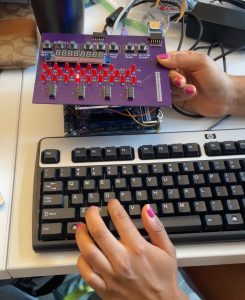The past two weeks, Amelia and I have made good progress on the RTL. We currently have a working implementation of the rotary encoder, which can change the number displayed on the on-board 7 segment displays, but we do have some strange jumping issues when we try to implement it by scrolling through the alphabet, since there is some unexpected behavior on reset. Additionally, we spent the majority of our time working on the external seven segment display that uses the MAX7219 chip. We had a lot of trial and error trying to adapt Arduino library code and existing RTL code (that was in VHDL, not Verilog) to work in Verilog. We used an Arduino to verify that the display itself worked, but after a lot of debugging, we successfully displayed a message early this week!
Later this week, Amelia and I worked on expanding our implementation of the variable rotor settings. For our demo, we only had users change the rotor starting setting (A-Z), but still hardcoded the rotor type (1-5) and ring starting setting (A-Z). On Friday, we spent most of the day implementing this and got all of the settings to display on the external 7 segment display! These settings could all be changed using the switches and buttons on the DE-10 and we verified that changing these settings reflected in accurate encryptions using an online Enigma simulator.
Now that the PCB has arrived, Amelia and I need to start wrapping up our RTL. This week, we will work on the shift registers for the lampboard, which should be pretty simple, and we will debug the rotary encoder implementation too. This will keep us on schedule.
As Amelia and I have been working on the RTL, it was very helpful to verify the individual components along the way. This made integrating them much easier. For example, we first got the rotor settings to display on the on-board DE-10. Using the on-board I/O (buttons and switches), we verified that the rotor settings could be changed and that they were correct when compared to the original Enigma machine using an online simulator. This included focusing on edge cases like the wrap-arounds from Z-A and the transitions at the knockpoints, which cause the other rotors to rotate as well. We also individually tested that the 7 segment display worked, and then incorporated that with displaying the actual settings. We will continue to run these targeted tests around edge cases and plan on conducting user testing to see how people who are not familiar with the design will interact with it. We want to ensure that the encryption is always 100% correct.



